Caterham ups the old-school design ante with the Seven Sprint
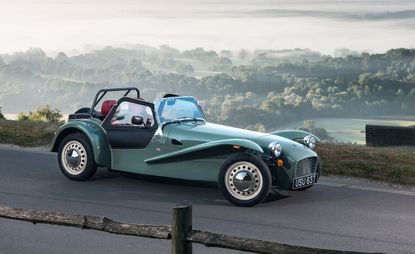
Caterham's evergreen Seven is already a slice of pure automotive nostalgia, but in its newest Sprint trim it ups the ante in terms of old school design. The Sprint has been created – in a strictly limited edition of 60 – to celebrate the 60th anniversary of what must one of the oldest pieces of car design still in production. The Seven began life as a Lotus, the purest evocation of company founder Colin Chapman's ethos of engineering minimalism. After Lotus moved on to making more substantial automobiles, it licensed the Seven to several manufacturers, one of which, Caterham, still builds their cars south of London and keeps the flame alive.
Chapman's original spirit of simplicity lives on in the entry-level 160 model, which matches a simple Suzuki engine and gearbox with the peerless handling and feel of this tiny machine. The joy of the Seven is its flexibility. With its skinny tyres and 80hp three-cylinder engine, the 160 delivers the purest of driving thrills. If you can cope, the company ramps up the power output (and price), all the way up to the flagship 620R model, which has three and a half times the power and just as little weight.
The Sprint is based on the entry-level 160 model, giving it the perfect sporting character – you don't want a gnarly, ferocious beast to wrestle with on a pleasant weekend road trip. Typically, buyers of the lowlier Sevens are given the choice of assembling the cars themselves, but the Sprint is factory built, given its aspirations to craftsmanship. As a result, there’s a welcome dose of added quality, courtesy of a full leather interior, slim wooden rimmed steering wheel and the odd splash and dash of chrome.
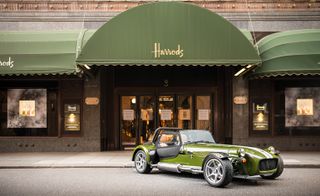
As part of a new personalisation programme, Caterham has released a Harrods edition of its Sprint Seven in the department store’s signature green
While all this adds a welcome sense of comforting enclosure, especially with the hood up, the Seven is never going to be a cocoon-like GT. Caterham's closest competitor is probably Morgan, but despite being fellow purveyors of skillfully updated archaisms, a Morgan feels like a Rolls-Royce in comparison to the utterly functional feeling of driving a Seven.
There is a lot to like, not least the strong feeling that this kind of car-driver relationship is not long for this world. Every single move you make in a Caterham is a true synthesis of driver and machine – you feel every bump in the road, see your wheels turning, experience the engagingly chirpy sound produced by the tiny engine and generally get a sense of how things used to be back in the days when driving was a form of physical endurance and not just an excuse to rifle through great tranches of multimedia as you stifle a yawn in near-autonomous silence.
Caterham can't help you with in-car entertainment of the audio kind. Certain details are rough and ready, like the indicator noise that sounds like an HGV is reversing into your blind spot, or the gaps in the canvas that let in the occasional stray drop of water. The Sprint is a very binary car; things are either on or off (and you either like it, or you don't). The windscreen wipers are either on or off. The heater is either on or off, blowing air from an indistinct part of the dashboard and making the flimsy cabin reach a passable level of cosiness – or at least half of it. Most of the time your right side is catching a chill from the imperfect arrangement of canvas and plastic that makes up the hood, while your left kneecap gets a roasting. Push really hard, and you'll find that you either have traction or you don't, but luckily the precise, dextrous brilliance of the steering mean that total control is really very much in your hands at all times.
That's a comfort, given this car's diminutive character. You sit at eyeball level with the wheel nuts of 30-tonne trucks, disconcerting in a traffic jam, near terrifying when passing at speed on the motorway. Yet because you're such an automotive minnow, the Sprint makes a fantastic, albeit unconventional, city car, compact and economical and perfect for short, spirited hops.

The cockpit of the Caterham Seven Harrods Edition
At some point in a long, late loop around South London, we are joined by the genuine article, a 1930s two seater of indeterminate provenance. Three quarters of a century separates these two cars, but the basic experience seemed remarkably similar, as we roared away from the traffic lights, rain spraying up around slender wheel arches and drumming down on canvas hoods. At such moments, the Sprint makes perfect sense, a time machine that captures just the right elements of a bygone world.
The Sprint apparently sold out instantly, so dealers will have to be cajoled if you want one of the original cars. But if you want a similar experience, Caterham recently announced a new personalisation programme, 'Caterham Signature'. Although there'll never be the scope to enhance your Caterham in the same manner as an Aston or Bentley, the first fruits of the operation are demonstrated by a new Harrods Special Edition. We're not sure what Colin Chapman would make of what is probably the most ostentatious Seven ever built, but it points the way towards a future of greater customisation – and perhaps slightly more creature comforts – for what is one of the world's great motoring experiences. Keeping the Seven alive for many more years can only be a good thing.
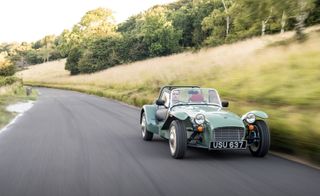
The Sprint is based on the entry-level 160 model, giving it the perfect sporting character
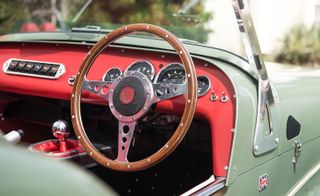
The cockpit is purely functional
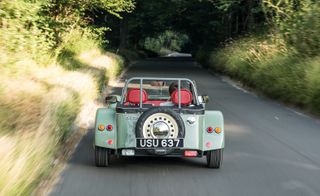
Every single move you make in a Caterham is a true synthesis of driver and machine
INFORMATION
Caterham Seven Sprint, £27,995; and Caterham Seven Harrods Edition, £59,999. For more information, visit the Caterham Cars website
Wallpaper* Newsletter
Receive our daily digest of inspiration, escapism and design stories from around the world direct to your inbox
Jonathan Bell has written for Wallpaper* magazine since 1999, covering everything from architecture and transport design to books, tech and graphic design. He is now the magazine’s Transport and Technology Editor. Jonathan has written and edited 15 books, including Concept Car Design, 21st Century House, and The New Modern House. He is also the host of Wallpaper’s first podcast.
-
 Morgan take their classic roadster and give it subtle but significant tweaks for 2024
Morgan take their classic roadster and give it subtle but significant tweaks for 2024New details and features give the compulsive Morgan Plus Four an even more pared back silhouette and driving ability
By Jonathan Bell Published
-
 Wallpaper* Class of '24 exhibition now open at Triennale Milano
Wallpaper* Class of '24 exhibition now open at Triennale MilanoWallpaper* Class of '24 exhibition at Triennale spotlights international emerging talent in furniture and product design, with the support of AHEC and SNOW (until 21 April 2024)
By Rosa Bertoli Published
-
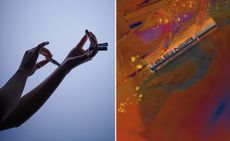 Bleu Nour is a new perfume brand bottling the sexy scent of cannabis
Bleu Nour is a new perfume brand bottling the sexy scent of cannabisBleu Nour is shaking things up in the London world of perfumery with Canna Crush, a new cannabis-based fragrance
By Mary Cleary Published
-
 Peugeot’s sparky 308 gets hybrid power and handsome lines
Peugeot’s sparky 308 gets hybrid power and handsome linesThe Peugeot 308 proves that mass-market design needn’t be dull, blending hybrid power with sharp lines and excellent detailing
By Jonathan Bell Published
-
 BMW Motorrad brings out the big guns for its newest cruisers
BMW Motorrad brings out the big guns for its newest cruisersBMW Motorrad R 18 Bagger and Transcontinental set the tone for high-voltage cruising with a brand collaboration with speaker specialist Marshall
By George Chapman Last updated
-
 Dacia’s new Manifesto concept is a true outdoor utility vehicle
Dacia’s new Manifesto concept is a true outdoor utility vehicleUtilitarian auto brand Dacia sets a bold new agenda with its Manifesto, a concept car pitched at the active outdoor market
By Jonathan Bell Last updated
-
 The sun sets on traditional supercars at California’s Monterey Car Week
The sun sets on traditional supercars at California’s Monterey Car WeekMonterey Car Week, the world’s most prestigious car gathering, is showcasing ever-more extravagant special editions, coachbuilt cars and all-new electric concepts. Here are seven key machines from 2022
By Rory FH Smith Last updated
-
 Is McLaren’s GT a sports car, a tourer, or the best of both?
Is McLaren’s GT a sports car, a tourer, or the best of both?The McLaren GT is a capable all-rounder dressed up in svelte supercar clothes. It might also be the last of its type
By Jonathan Bell Last updated
-
 Rolls-Royce puts the Phantom back on its lofty pedestal
Rolls-Royce puts the Phantom back on its lofty pedestalA mid-life refresh ensures the flagship Rolls-Royce Phantom Series II is at the top of its game, a last hurrah for traditional engines before an electrified future
By Jonathan Bell Published
-
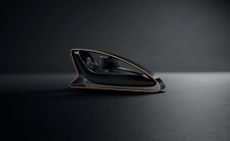 Prodrive’s new racing simulator is shaped by Callum to be front of the grid
Prodrive’s new racing simulator is shaped by Callum to be front of the gridThe racing simulator shapes up – this new design from Prodrive and Callum is honed for the high-end games room
By Jonathan Bell Last updated
-
 928 by Nardone Automotive: a restomod Porsche with Gallic verve and Italian style
928 by Nardone Automotive: a restomod Porsche with Gallic verve and Italian style928 by Nardone Automotive is a gracefully modernised version of Porsche’s endearingly different 928
By Jonathan Bell Last updated